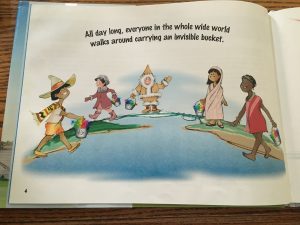Title: Have You Filled A Bucket Today? A Guide to Daily Happiness for Kids 
Author: Carol McCloud
Illustrator: David Messing
Publisher and Year: Ferne Press, 2006
Number of Pages: 31
Genre: Fiction
Analysis: Have You Filled a Bucket Today? is a children’s picture book which received a Mom’s Choice Award, and teaches children the benefits of kindness to everyone, even complete strangers. Throughout the book a bucket is used as a symbol of a person’s happiness. If the bucket is full, then a person is happy, but if the bucket is empty a person is sad.
Have You Filled a Bucket Today? includes five different cultures on the first page and continues to show people of different races and ages throughout the book. Not only are different races and ages exhibited throughout the book but also a child in a wheelchair is represented. This book can serve as a mirror for a reader who is acting in a caring and loving manner towards others, but this book could also be considered a door since it encourages others to act and fill other people’s buckets. Society often thinks that adults have the influence, but this book shows that through simple actions, children can impact their peers, adults, teachers, and even strangers.

Perceptually, this book appears to be a happy and joyful book. The text is big,clear and easy for students to read. The amount of text represented on each page is just enough to grasp the understanding and then move on to the next page. Each page adds onto the previous page, while still reflecting the same message.
Structurally, the diverse characters vary, but the image of the bucket remains the same. The bucket reflects a character’s outward appearance. For example, characters that wear glasses have a bucket that wears glasses. This artistic style shows the audience that the bucket is not an item separate from the person. A bucket is symbolic of the person’s feelings and emotions on the inside. Since this book suggests that children have the power to impact a person’s happiness, the images of children and adults are on the same level. This image is a powerful point because it shows that children can impact adults just as much if not more than adults can impact children. Throughout the book, the images mirror the text, showing exactly what is written, but in some instances the images add to the text further explaining the story through pictures.

Finally, ideologically this book’s positive message will have a lasting effect on children more than the negative lesson. One aspect that was negative was when the author points out that a bully is a “bucket dipper” (p. 15). The illustrator adds onto these words by creating images that show bullying actions. These words and images give children examples of ways that they should not behave towards their peers. The first positive message shows children the affect that happiness can have on other people as well as their own happiness. Not only does this book portray a positive message overall, but also there are relatable examples that students can take away from this book.
